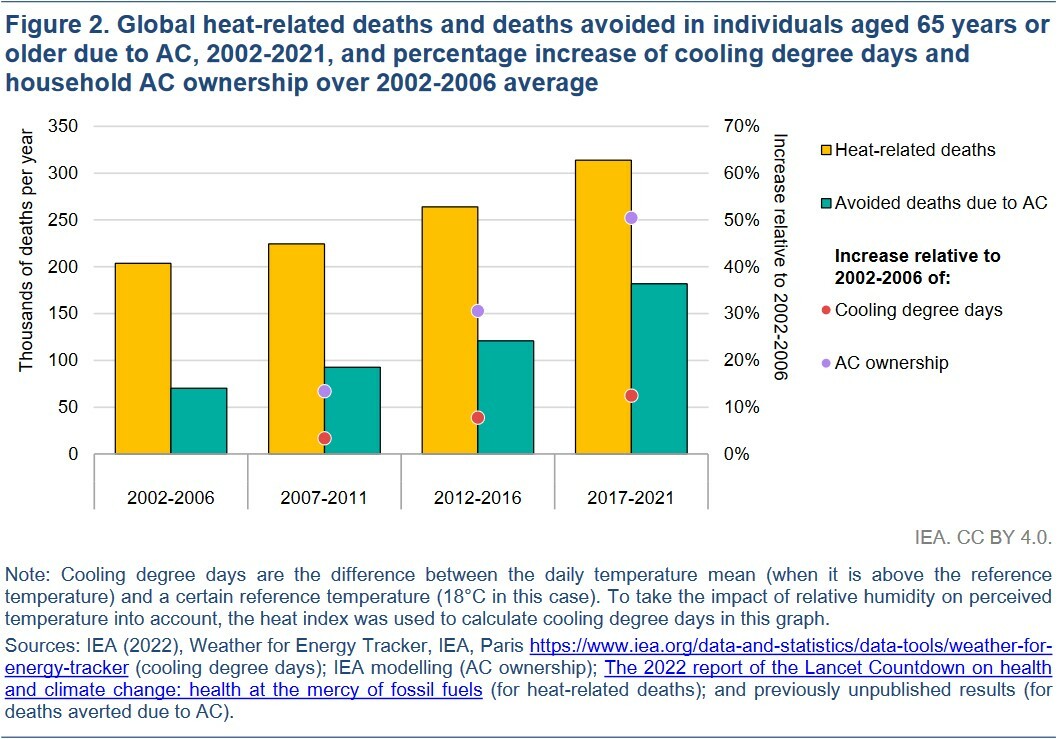Access to air conditioning saved over 190,000 lives in 2019
In the 2022 report for the Lancet Countdown on health and climate change, the authors estimated the number of heat-related deaths averted thanks to air conditioning, especially among high-risk senior and elderly people.
As global temperatures rise due to climate change, a growing number of people around the world are exposed to the potential harm caused by heat stress. [1] Adaptation through the use of air conditioning is becoming a vital necessity as it can contribute to maintain labour productivity and benefit human health. [1, 2] Yet, of the 3.5 billion people who live in hot climates, only about 15% owned air conditioning (AC) in 2021, with even lower ownership levels in Sub-Saharan Africa and South Asia, according to a recent report by the IEA.[3]
According to the 2022 Lancet Countdown on health and climate change, of all natural disasters, heatwaves cause the most deaths, with older adults, people with cardiovascular disease, people living in poverty, and people isolated in low-cost housing most at risk. [4] Between 2002-2004 and 2019-2021, the average annual number of heat-related deaths among people aged 65 years or older increased by 61%, to an estimated 300 000 or more. [3]
The Lancet report estimated that in 2019, around 195 000 heat-related deaths were averted thanks to AC access among people aged 65 years or older. In addition, according to the IEA, this number of deaths avoided has been multiplied by 3 compared to 2002.[3]
The research was based on data provided by the IEA, along with other data. Estimating global heat-related deaths and deaths averted by AC pose data availability and methodological challenges. Nevertheless, according to the IEA, it is clear that hundreds of thousands of people die from heat each year, and that AC helps avoid tens of thousands of additional deaths. [3]
Passive cooling solutions are preferable for protecting the climate, conserving energy, and keeping energy costs low. According to an IIR Informatory Note, under the most favourable conditions, passive cooling can fully meet the cooling demand of a building, possibly assisted by an appropriate cold storage.[5] However, with rising incomes and a hotter climate, the IEA estimates that global household AC ownership will reach 45% by 2030, up from 35% in 2021.[3] The IIR believes that even when the possible contribution is only marginal, hybrid systems can be designed, combining one or more passive technologies with conventional cooling technologies, allowing still appreciable energy savings.[5]
Coherent policy packages supported by the necessary financing, are needed across local, national, regional, and global jurisdictions to ensure access to sustainable, affordable, energy-efficient air conditioning for all who need it. [3]
Sources
[1] Pavanello, F., De Cian, E., Davide, M. et al. Air-conditioning and the adaptation cooling deficit in emerging economies. Nat Commun 12, 6460 (2021). https://doi.org/10.1038/s41467-021-26592-2
[2] https://iifiir.org/en/news/extreme-heat-reduces-productivity-in-global-economies
[3] IEA (2023), Sustainable, Affordable Cooling Can Save Tens of Thousands of Lives Each Year, IEA, Paris https://www.iea.org/reports/sustainable-affordable-cooling-can-save-tens-of-thousands-of-lives-each-year, License: CC BY 4.0
[4] Romanello M., et al. (2022). The 2022 report of the Lancet Countdown on health and climate change: health at the mercy of fossil fuels. The Lancet, 400(10363), 1619-1654. https://doi.org/10.1016/S0140-6736(21)01787-6
[5] Lazzarin, R. (2022) Passive cooling technologies. 47th Informatory Note on Refrigeration Technologies. https://iifiir.org/en/fridoc/passive-cooling-technologies-47-lt-sup-gt-th-lt-sup-gt-informatory-note-on-145148

